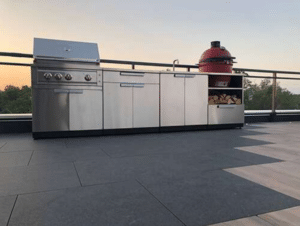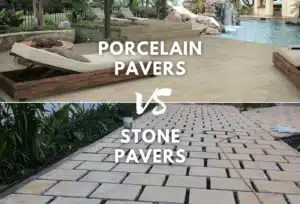When searching for an exotic hardwood, homeowners often wonder which wood is better, Ipe Wood or Garapa Wood? Good question, and ultimately the answer comes down to homeowner preference, overall look and feel and affordability.
While there may be many factors to consider, one thing is sure– both Garapa wood and Ipe woods are two beautiful hardwoods. Both have good qualities that make them popular among woodworkers, home builders, and architects. Ipe is best known for its appearance and durability. Garapa wood is loved for its beauty and strength.
If you want to be sure you are choosing the best wood for your home, then you should learn more about the distinct features of Ipe and Garapa wood.
Both Ipe and Garapa woods are native, sustainable hardwoods from South and Central America. People across Central and South America have used these durable and highly sought-after timbers used in construction and outdoor decking for hundreds of years.
To help you determine which hardwood is best for your home, we have decided to look at both varieties of wood. In looking at the differences between the two kinds of wood– including their characteristics and durability, we want to help you decide which wood is best for your home renovation and design project.
Garapa Wood
Garapa wood is sought after for its beauty and strength. Garapa wood has a beautiful texture and natural grain. The grain runs right down the center of the timber creating strong, well-defined grain lines. Garapa wood has been used for making musical instruments, furniture, and light fixtures for centuries.
bility
The apparent strength of Garapa wood and its appearance makes it a good choice for projects where strength and resilience are required. As such, Garapa wood is often used in projects that require a stable foundation. Thus, it is a good choice when you are considering indoor or outdoor flooring.
Due to its strength and durability, Garapa wood can hold up to wear and tear from frequent use without splitting or sanding. It is best used for buildings, fences, decks, patio flooring.
Hardiness
Garapa wood has a Janka hardness of 1,630 lbf (pounds per force). The only other wood decking stronger than Garapa wood is other high-density hardwood such as Ipe wood.
Bending Strength
Garapa wood will span greater distances with a minimal bend. The less bend in a deck board means that your floorboard is more solid and will “bounce” less when you walk on it.
Garapa Wood Advantages and Disadvantages
The overall advantage of Garapa wood flooring is price. Garapa wood flooring is about 30-40% lower in price.
Ipe Wood
There are a lot of advantages to using Ipe wood flooring. Ipe wood is darker in appearance and has a smoother finish. It also has a more consistent grain appearance. Ipe wood has a natural ability to stand up better to changes in weather and other environmental factors.
Overall, Ipe wood is best known for its appearance and durability.
bility
Ipe wood is resistant to attack by decay, fungi, and termites. Typically, Ipe wood can last 40-50 years or longer when properly cared for.
Hardiness
The Janka rating for Ipe wood is 3,680 lbf–more than double the toughness of Garapa wood. Therefore, it is more resistant to scratching and gouging. Ipe wood also has natural fire resistance. It makes it an excellent choice for decks near fire pits, chimneys, outdoor fireplaces, BBQ grills. For those who smoke, burns caused by cigarettes are not a problem with Ipe wood floor.
Because of its hardy nature, Ipe wood is a good choice of wood to use around children and pets.
Bending Strength
Ipe has a high bending strength of 23,360 psi. That means you would have to apply excessive force per square inch to break a board. Because of its strength, Ipe hardwood exhibits minimal flex or “bounce” when you walk on it.
Ipe Wood Advantages and Disadvantages
As Ipe wood ages, it releases an oil. The scent from this oil repels bugs. Ipe wood is also resistant to moisture. Thus, protecting it against mildew and mould.
Ipe wood’s naturally hard and durable nature make it nearly impossible to drill holes in the wood after placing it on the deck
Homeowners should buy Ipe wood from a reputable source as Ipe wood is sometimes sourced from protected forests. Though it does cost a little more–$3.50 to $5 per square wood, many people find that the benefits of Ipe wood outweigh its challenges.
Pro tip
Both Ipe and Garapa woods are extremely heavy. Hiring professional outdoor wood flooring specialists to do the installation will help save your back and ensure proper installation.
In addition, the density of the wood may require special tools to cut and assemble each piece to ensure a tight fit.
Check with your local supplier to ensure that your wood of choice is harvested responsibly and ethically. The Forest Stewardship Council certifies wood based on sustainable harvest practices.
Urban Balcony and flooring can provide you with more details. Both Ipe and Garapa wood are available in various sizes of tiles. Exotic woods are a great addition to any exterior design, whether that’s a home addition to an exterior deck or another feature to upgrade your outdoor living experience.
All the best!
Dave Rea







